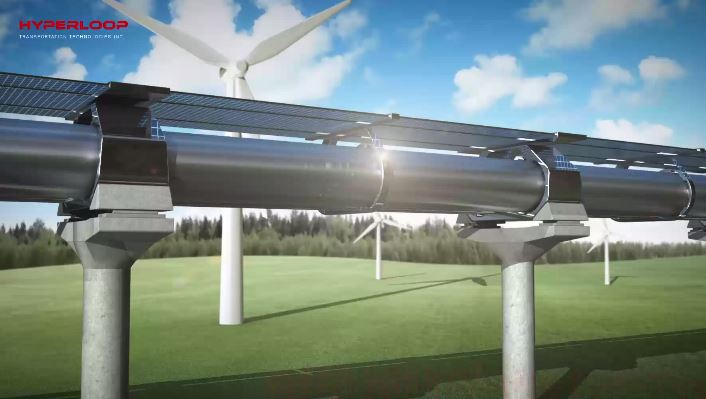There are three different Hyperloop concepts under development. Could any of them really disrupt the freight transport industry?
In 2013, engineer and entrepreneur, Elon Musk, revealed some draft plans for a dynamic transportation system that would see the movement of people and goods using a massive vacuum. It would be called the Hyperloop.
The idea of Hyperloop is a low-pressure system that runs inside a tube, with a capsule that hovers inside this tube, using magnetic force to retain its position. Because of the low pressure, there is little to no resistance. The result is a method of transportation that the scientists behind the idea say is very energy efficient. 
Musk, the man beind Space X and Tesla, has let anyone who can push on with designing and developing the Hyperloop concept. Three of them are Hyperloop Transportation Technologies (HTT), Hyperloop One, and Delft Hyperloop. This month Musk announced that his own company, the Boring Company, will build a Hyperloop network between New York and Washington D.C, although confirmation of this is yet to come.
To date, Hyperloop One has achieved the most progress. In July this year, it announced a successful test run on its DevLoop test track in Nevada, reaching a speed of 190mph in 5 seconds. It plans to reach 250mph in subsequent testing. Hyperloop One is considering 11 possible routes for the first US-based system but is simultaneously carrying out feasibility studies in Dubai and Finland.
Hyperloop Transportation Technologies HTT) is also on its way to building the first Hyperloop, with 7 contracts signed so far, according to Bibhop Gresta, HTT’s Chairman. HTT’s first Hyperloop will be built in Abu Dhabi, according to Gresta. HTT has the support of the Abu Dhabi government which has funded the project with a huge investment, and once a conditional permit is given, it will be 38 months until the first Hyperloop is built.
Cargo is less sensitive to vibrations and safety issues, so it is likely that Hyperloop will be used to transport cargo before passengers. Such an unconventional system will surely be a disruptor for shipping and port operations, though potentially for hinterland operations.
Fleets of trucks currently move goods from ports to warehouses and their final destinations, burning gallons of fuel and emitting tonnes of greenhouse gases on a daily basis. The American Trucking Association estimates that 3 million trucks requiring more than 37 billion gallons of fuel move through the US every year.
Gresta, talking to Fathom-News about his ambitions, says envisions a maritime industry with no ports and no need for these trucks. Instead, the Hyperloop will be the biggest disruptor the shipping industry has ever seen, taking goods directly from the ship and transporting them to various destinations via the unconventional floating tube system. Not only will it do this but by harnessing wind power, kinetic energy and geothermal power, HTT’s Hyperloop will generate 30% more power than it consumes, claims Gresta.
HTT has also signed a deal with German company, Deutsche Bahn to develop a train that uses Hyperloop features, which could too be used to transport cargo.
Netherlands-based Delft Hyperloop, a third company company vying to become the first Hyperloop creator, sees the Hyperloop being used to take cargo from Rotterdam to Berlin, a busy truck route at the current time.
Hyperloop freight systems would be used to enhance container shipments, clearly there being little need for the concept to be used in many bulk operations where time is not a critical factor.
Once a container has reached land, instead of being placed into a truck it will be dropped into a Hyperloop capsule and sent swiftly on its way, arriving at its programmed destination in a fraction of the time.
In Hyperloop One’s vision, shipping and port logistics will be completely changed by using Hyperloop to connect vessels to the shore, allowing cargo to be unloaded offshore. It will be used to transport cargo from port locations to other destinations without the use of trucks and lorries, both reducing pollution and opening up what would have been port land for redevelopment.
Is cost the show stopper?
This company is steaming ahead with its plans, having already secured US$50m in funding from DP World, one of the largest port and terminal operators in the world and in local competition with Abu Dhabi Ports (with its competing deal with HTT). This money will go towards building a Hyperloop for transporting cargo.
A Hyperloop won’t come cheaply though with estimates at around US $20-40 million per km. The companies claim that because of the vacuum, little maintenance will be required, there being no wear and tear as a result of friction because of the levitating capsules that remove this, and no mechanical parts. Robots and drones would be deployed to travel in the vacuum and carry out checks and eventually Gresta expects robots to be able to carry out actual maintenance onboard.
There is one barrier though and that’s regulation. Gresta confirms that HTT is working with German inspection and certification company, Technischer Überwachungsverein, to ensure the right safety standards are in place and to generate a framework, which they have proposed to the government of India and Abu Dhabi.
The movement of containers and cargo from the vessel to the Hyperloop would have to be done at the same speed as carried out now using trucks in order to make the Hyperloop efficient. There will have to be an efficient system that ensures the Hyperloop can handle the same speed and quantity of cargo as trucks do in order to make it disrupt current operations. Furthermore, there would need to be a number of specially built Hyperloop stations that the cargo can be dropped off at as driving a truck into a warehouse and unloading it will no longer be the simple way.
 Physical challenges such as thermal expansion and cyber security are also issues that have been raised. A transportation system that moves at speeds of up to 800mph will require extreme safety measures to protect both people and cargo. However, many accidents on road, rail and air networks are attributed to the human element and as Gresta reassures, the Hyperloop will be so computerised and digital that most of the human element will be removed. Nothing on the planet will have this level of security and the Hyperloop will have a level of autonomy like no other, allowing it to read and react to situations and make decisions when necessary.
Physical challenges such as thermal expansion and cyber security are also issues that have been raised. A transportation system that moves at speeds of up to 800mph will require extreme safety measures to protect both people and cargo. However, many accidents on road, rail and air networks are attributed to the human element and as Gresta reassures, the Hyperloop will be so computerised and digital that most of the human element will be removed. Nothing on the planet will have this level of security and the Hyperloop will have a level of autonomy like no other, allowing it to read and react to situations and make decisions when necessary.
This technology is happening now. Both HTT and Hyperloop One have signed deals with nations and partnered with engineering firms. HTT has over 860 scientists from 42 countries working on the project. This technology is not futuristic, it is “presentistic”, according Gresta.
fathom-news.com

































